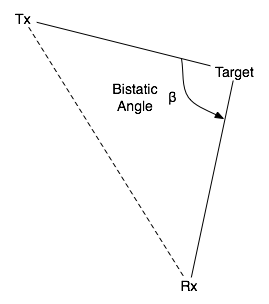Bistatic angle
The bistatic angle is the angle subtended between the transmitter, target and receiver in a bistatic radar. When it is exactly zero the radar is a monostatic radar, when it is close to zero the radar is pseudo-monostatic, and when it is close to 180 degrees the radar is a forward scatter radar. Elsewhere, the radar is simply described as a bistatic radar. The bistatic angle is an important factor in determining the radar cross section of the target.[1][2][3]

Illustration of bistatic angle
See also
- Bistatic radar
- Monostatic radar
- Passive radar
- Radar cross section
References
- Cherniakov, Mikhail (ed). (2007). Bistatic Radar: Principles and Practice. Wiley. ISBN 0-470-02630-8
- Willis, Nicholas. (2007). Bistatic Radar. SciTech Publishing. 2nd ed. ISBN 1-891121-45-6
- Willis, Nicholas J.; Griffiths, Hugh D. (2007). Advances in bistatic radar. SciTech Publishing. ISBN 1-891121-48-0.
This article is issued from Wikipedia. The text is licensed under Creative Commons - Attribution - Sharealike. Additional terms may apply for the media files.